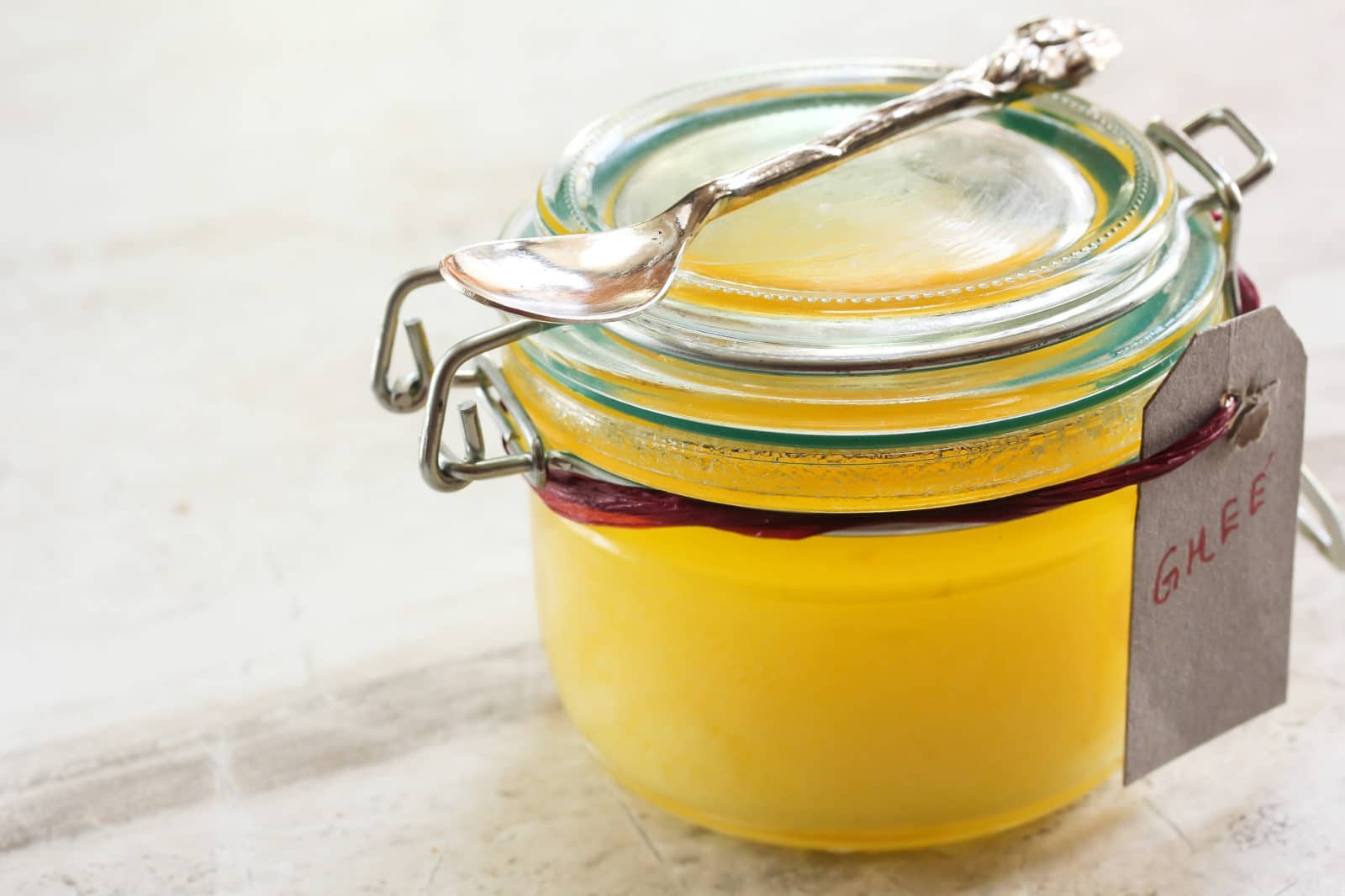Ghee is an essential ingredient in Indian cooking, a sacred ingredient whose purified essence nurtures and nourishes. When we make ghee, we witness a transformation. In the silence of the kitchen, we can almost meditate to the gentle crackling sound of butter simmering in the pot. Such a “feel good” sound! It is mesmerizing to watch butter boil as it undergoes an intended purification process. The alchemy of change is happening before our eyes.
Ghee is traditionally made by heating unsalted milk butter to just over 100 degrees Celsius, then straining out the separated milk solids, leaving the golden ghee behind. In this way, a dairy product is transformed into a vegan-friendly superfood. Though ghee is made from butter, it serves as an exceptional substitute for butter for those intolerant to milk. It also has a higher smoke point. And for those who desire its Ayurvedic benefits, the list is long:
- Balances Vata & Pitta
- Reduces poisons in body
- Increases memory
- Increases intelligence
- Contains healing properties
- Considered best among all fats
- Enhances hair growth
- Reduces inflammation
- Improves joint lubrication
- Aids in growth of healthy bones
- Considered to be dairy-free once the solids are removed
- Sweet in taste, cold in nature, and has a sweet aftertaste
- Considered to be soothing, soft, and oily
- Aids in digestion by stimulating the secretion of digestive fluids
- When used with herbs, ghee transports the herbs’ therapeutic properties to the tissues of the body
- Beneficial for detoxification
- Alleviates chronic fever, anemia, and blood disorders
- When mixed with warm milk, ghee can help with constipation
According to Ayurvedic principles, ghee is the most beneficial of all fats. “Ghee is considered as the best among all fats and is used as medicine by itself or as a media for extraction, absorption, and assimilation for any medicine,” (Tarla, p. 54). Many of us have misconceptions about ghee, treating it with the same uncertainty that we treat other types of fats doctors advise against. However, according to the ancient science of Ayurveda, ghee is not something we should avoid. Ghee is therapeutic. It facilitates good health and promotes well-being, skin nourishment, and lubrication of your digestive system and joints. According to Nourished Kitchen, ghee “is also rich in conjugated linoleic acid, a fatty acid that offers enormous value in a wholesome diet. Indeed, recent research indicates that CLA may be useful in the prevention of and fight against cancers as well as in the mitigation of type 2 diabetes and associated adipose obesity.”
Ghee’s miraculous properties facilitate balance for all three doshas. Its properties (sweet taste, cold nature, sweet aftertaste with oily, soft, heavy qualities) mean it is an excellent pacifier of aggravated Vata and Pitta doshas in the body. Ghee is said to contain all five basic life elements: ether, air, fire, water, and earth. Ghee is widely used in Ayurvedic practice to aid degenerative, chronic, and inherent diseases. Appropriate for all ages, ghee promotes the growth of all seven dhatus in the body (body fluids, blood, flesh, fat, bones, marrow, and semen). When combined and prepared properly, the medicinal properties of herbs are infused into the ghee. These herbal-ghee infusions can be used to treat illnesses.
Beyond the nutritional benefits, ghee can serve as an allegory for our own transformation. Just as the butter is exposed to heat, our own bodies grow and change when they are pressed into work. When we do yoga, we are heating up our bodies and working through blocks that are around us. Whether the heat comes from yoga, yard work, or life experience of any kind, we transform and grow when confronted with a challenge. Hopefully, we are purified through our experiences. We humans need these challenges in our lives to help us become more pure, just as the ghee is purified by exposure to heat.
That’s what we are doing in our lives every single day. When we go from one job to another, that process purifies us. We learn something from it—perhaps discrimination (we liked or didn’t like it). That beginning, middle, and end is represented in making and using ghee. That’s the vinyasa of life, and ghee reminds us that cycles like this repeat over and over. Every time we come back to our yoga mat, every time we begin a job, every time we take butter to frying pan, we can witness the purification that comes with hard work.
We can carry that image with us as we work through our own purification, safe in the knowledge that whatever the present challenge, we will be transfigured by the process.


